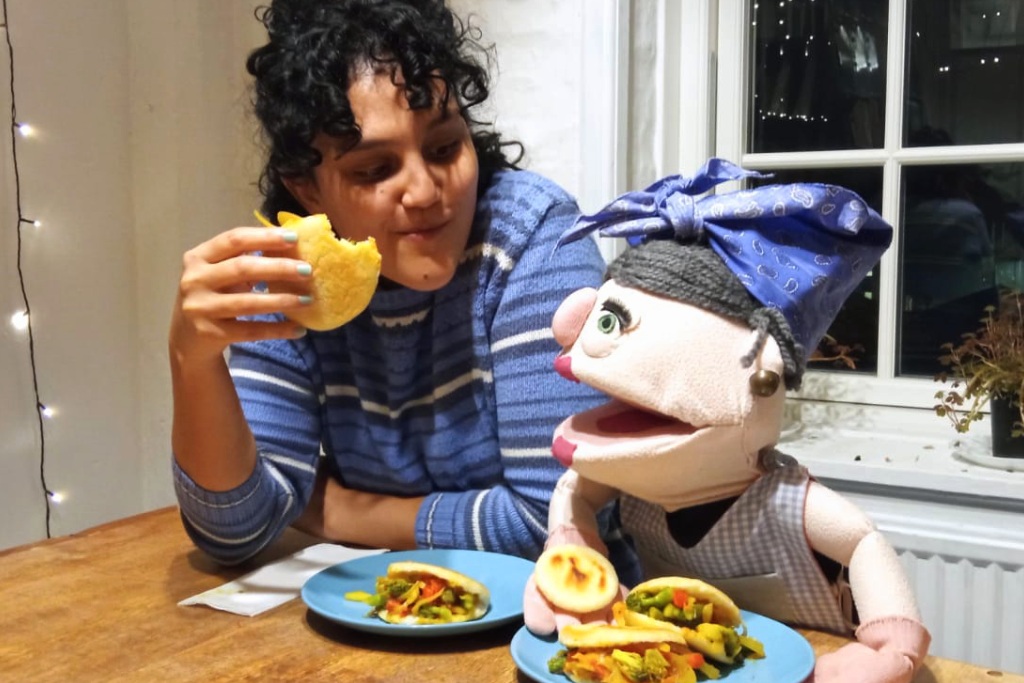Plant-based Venezuelan-style arepas

🥙🗑️🤔 Did you know that homemade arepas are versatile, naturally vegan, and the perfect way to cook with zero waste using plant-based filling whatever you have in your pantry? Arepas de maíz are mostly known as corn cakes made out of precooked corn flour/cornmeal in a flat circular shape, similar to a pancake. It can be cooked on a grill, fried, or roasted and welcomes every stuffing you can imagine.
🌱🇻🇪 Angélica joined A Grandchild in My Kitchen, Grandma Sita’s plant-based cooking challenge of getting inspired by worldwide family dishes to twist them into delicious new plant-based meals. So let’s make delicious Venezuela-style sandwiches stuffed with colorful sautéed vegetables that will immediately gain a place in your heart and kitchen.
😋 This yummy plant-based recipe is inspired by the popular Venezuelan arepas versatile, and naturally vegan. The Colombian and Panamanian arepas versions are thinner and work better to have a bite as you munch them with something else, like french fries.

INGREDIENTS
*For the arepas (10 units approx.)
2 cups Harina P.A.N (pre-cooked white corn flour)
2 and 1/2 cups warm water
1 tsp sea salt
1 Tbsp vegetable oil
Tip: if avoiding oil, just omit it and be sure your pan is non-stick.
*For the filling
1 onion, chopped
1 bell pepper, chopped
Half broccoli, chopped
2 tomatoes, chopped
A bunch of asparagus, chopped
Salt & back pepper, to taste
METHOD
*For the arepas
1. Stir water and salt together in a medium bowl; gradually stir in cornmeal with your fingers until the mixture forms a soft, moist, malleable dough.
2. Knead for 2 minutes and let it rest for another 5 minutes.
3. Divide the dough into balls, around 10 units, and flatten them with your hands until you get discs.
4. Heat oil in a large skillet over medium heat; fry arepas in batches, about 10 minutes per side to form a crust and to ensure the centers are cooked through.
Tip: The key to perfectly crisp-on-the-outside, tender-and-fluffy-on-the-inside arepas!
5. Transfer cooked arepas to a paper towel-lined plate to drain until cool enough to handle.
*For the filling
1. Wash all vegetables well and chop them.
2. Heat vegetable oil in a pot. Sauté chopped onion until soft and add all veggies, salt, and pepper. Mix well, and cook over medium heat until the veggies are tender, stirring occasionally.
*To assemble the arepa
1. Slice halfway through each arepa horizontally with a thin serrated knife to form a pita-like pocket and start filling them.
2. Serve with salad or anything else you like, and Bon appetite!

👵💚 Grandma Sita’s tips:
*Arepa flour is a refined, pre-cooked corn flour. It comes in both white and yellow, the only difference being the colour of the flour. Thankfully, arepa flour is becoming much easier to find. Always look for “harina de maiz blanco precocida” near the bottom of the flour package.
*Overall, arepas naturally gluten-free are a healthy choice when compared to other types of bread. They provide complex carbohydrates, protein, and fiber, and are low in fat. Polenta and corn flour are almost the same product, except for the consistency of the grain.
*The recipe for arepas dough is simple and they can be kept in the fridge once made for up to 4 days. Arepas can also be frozen; layer between parchment paper to prevent sticking.
📗 The name arepa is said to be derived from “erepa”, the word for cornbread in the Cumanagoto language. Arepa is a pre-Columbian dish from the area that now makes up Colombia, Venezuela, and Panama. Nowadays Arepas are a delicious staple in both Colombia and Venezuela, but corn-based food can take different forms depending on who is preparing it.
♻️🌎 Nearly half of all fruits and veggies produced globally are wasted each year. Let’s not add to that statistic by making nutritious veggie arepas that will keep ourselves and the planet healthy.
